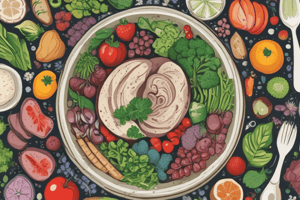Podcast
Questions and Answers
Which of the following nutrient-dense food groups provides approximately 4 calories per gram?
Which of the following nutrient-dense food groups provides approximately 4 calories per gram?
- Fiber
- Protein
- Carbohydrates (correct)
- Fat
What is the primary purpose of portion control in meal planning?
What is the primary purpose of portion control in meal planning?
- To ensure adequate nutrient intake (correct)
- To reduce food waste
- To promote weight loss
- To manage blood sugar levels
Which of the following is a key consideration when planning menus for individuals with food allergies?
Which of the following is a key consideration when planning menus for individuals with food allergies?
- Cultural and lifestyle influences
- Food cost and budget
- Nutrient density of food
- Cross-contamination of allergens (correct)
What is the primary goal of menu planning for special diets?
What is the primary goal of menu planning for special diets?
How do cultural and lifestyle influences impact food choices and menu planning?
How do cultural and lifestyle influences impact food choices and menu planning?
What is the recommended daily intake of fiber for adults?
What is the recommended daily intake of fiber for adults?
Which of the following is a key principle of nutrient-dense eating?
Which of the following is a key principle of nutrient-dense eating?
What is the primary benefit of incorporating nutrient-dense foods into meal planning?
What is the primary benefit of incorporating nutrient-dense foods into meal planning?
How do special dietary needs, such as diabetes or celiac disease, impact menu planning?
How do special dietary needs, such as diabetes or celiac disease, impact menu planning?
What is the primary goal of the Dietary Guidelines for Americans?
What is the primary goal of the Dietary Guidelines for Americans?
Flashcards are hidden until you start studying
Study Notes
Personalized Meal Planning
- Meal planning tailored to individual dietary needs, such as low-carb or low-fat diets, helps people achieve their nutritional objectives.
Education and Awareness
- Using an exchange list helps people understand the macronutrient composition of foods and recommended serving sizes.
- The exchange list provides a standardized method for meal preparation, offering consistent nutritional advice.
Consistency in Dietary Advice
- The exchange list offers a well-accepted industry standard for meal planning.
Limitations of Exchange Lists
- Limited variety: not all foods in each exchange group are typical of that category, reducing meal variety.
- Inaccurate portion sizes: exchange list portions may not be accurate or typical of how people eat those dishes.
- Not tailored to individual needs: the exchange list is a broad guide, not adjusted for specific requirements, dietary restrictions, or cultural preferences.
- Doesn't account for micronutrients: the exchange list focuses on macronutrients (carbohydrates, protein, and fat), not micronutrients.
- No information on water intake or recommended daily amount.
Exchange List and Menu Planning
- An exchange list categorizes foods by macronutrient composition (carbohydrates, protein, and fat) and provides serving sizes.
- Categories include:
- Milk and Yogurt
- Starches
- Beans, Peas, Lentils
- Fruits and Juices
- Non-Starchy Vegetables
- Fats
- Meat and Meat Products
Benefits of Exchange Lists
- Flexibility in meal preparation: offers a range of food options within each group, allowing people to select items suiting their preferences and dietary needs.
- Better portion control: helps control calorie intake and portion sizes by listing serving amounts for each food group.
Studying That Suits You
Use AI to generate personalized quizzes and flashcards to suit your learning preferences.




